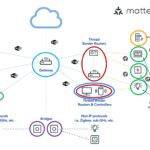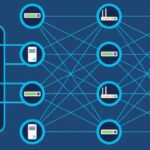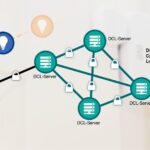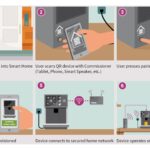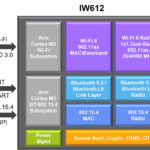Matter has been called an interoperable application layer solution, and the same source, the Connectivity Standards Alliance that oversees the development of Matter, refers to it as a protocol.
This FAQ explores the definitions of communications interfaces and protocols. Compares those definitions with Matter and presents the possibility that Matter is not a protocol but a new type of middleware for wireless Internet of Things (IoT) devices.
Interfaces like RS232, RS422, and RS485 provide physical links between systems, while human machine interfaces (HMIs), like touch screens, link systems, including industrial systems, computers, and communications devices, with operators and users (Figure 1). HMI specifications are generally related to ergonomics and psychology to support the needs of human users. HMIs are also called user interfaces (UIs) and can be made up of multiple physical devices like touch screens, keyboards, monitors, speakers, printers, etc. These various devices are called human interface devices (HIDs).

Machine-to-Machine interfaces
Just as there’s a wide variety of HIDs designed for specific purposes, there’s a wide range of machine-to-machine interfaces such as serial buses, Fieldbuses, Ethernet, etc. Some serial buses use protocols like IO-Link to connect individual devices to a controller. The controller area network (CAN) serial bus can be implemented in a multi-master configuration with numerous devices sharing the bus.
Fieldbus profiles are standardized by the International Electrotechnical Commission (IEC) as IEC 61784 and 61158 and can support various topologies like ring, branch, star, and daisy chains. In many industrial settings, Fieldbuses have replaced RS-232 and RS-422 serial communications. An important advantage of Fieldbuses over other solutions is determinism. Communications can be received and acknowledged in real time, an important feature in industrial process control systems.
Many Fieldbus standards include RS-485 transceivers as an option for the physical layer. RS-485 transceivers are inexpensive and have multiple speed ranges and other important features. Fieldbuses use a single bus to connect all devices on a network with a single controller. That arrangement reduces the amount of wiring needed and increases system modularity, both important considerations in industrial installations. A Fieldbus provides the physical layer and can be used with many communication protocols such as Foundation Fieldbus, EtherCAT, Profinet, Modbus, HART, etc.
Protocol suites and stacks
Communication protocols are composed of suites and stacks. A protocol suite is a general specification of how the protocol is structured and what elements are included. The protocol stack, known as the network stack, is a specific protocol suite implementation. Specialized protocol stacks can be developed from protocol suites to address specific communication and application needs. Each module in a protocol stack typically communicates with two other modules, hence the concept of being stacked on top of each other. The lowest layer in the stack links to the hardware interface, such as an HMI or a communications device like a radio. Moving up the stack adds functionality; at the top, the stack links with the application software. Examples of protocol suites include the open systems interconnection (OSI) model and the Internet protocol (IP) model.
The International Standards Organization (ISO) designed the OSI suite to provide an everyday basis for developing communications standards. The OSI suite and related standards partition the communications stack into seven abstraction layers beginning with the physical system interconnection (interface) at the lowest level. The layers in the stack include; Physical, Data Link, Network, Transport, Session, Presentation, and Application (Figure 2). Each intermediate layer in the OSI suite provides specific functionality to the layer above it and is supported with specific functionality from the layer below it.
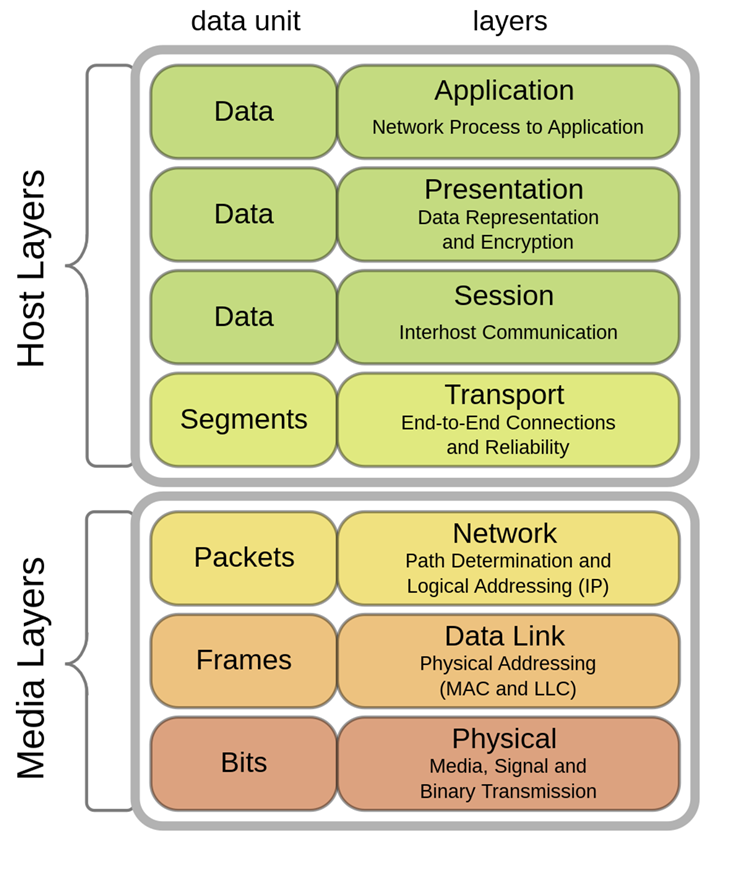
An important aspect of a protocol stack is that each layer must have unique and well-defined functions, and the suite must define the interactions between adjacent layers. The OSI and IP communication protocol suites meet these requirements and can be used as the basis for multiple communication protocol implementations.
The IP suite is built using a very different model than the OSI. Instead of being built on ISO standards, the IP suite is built using a series of documents individually called a ‘Request for Comments’ (RFC). Each RFC is a formal document from the Internet Engineering Task Force (IETF) that includes specifications and organizational notes about specific topics (layers) like routing, addressing, and transport technologies related to the Internet. According to the IETF, there are over 9,000 individual RFCs.
The lowest layer in computer communications, including the IP suite, is called the link layer. It’s like the combination of the data link layer (layer 2) and the physical layer (layer 1) in the OSI stack, described in RFC 1122 and RFC 1123. The combination of RFC 1122 and RFC1123 is similar to, but not identical to, the combination of layers 1 and 2 in the OSI stack. RFC 1122 includes local area network protocols such as Ethernet and other IEEE 802 networks like Wi-Fi and framing protocols such as Point-to-Point Protocol (PPP) that belong to the link, IP, and transport layers. RFC 1123 covers the application and support protocols.
Matter provides an abstracted application layer on top of IP protocol stacks like Wi-Fi, Ethernet, and Thread (Figure 3). Matter was developed to improve the interoperability and security of devices and simplify solution development across various IP connectivity protocols and technologies.
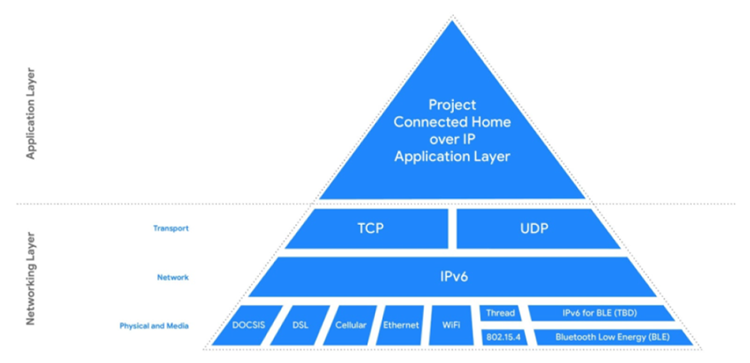
Trying to classify Matter as a type of software can be challenging. A significant difference between Matter and the protocol stacks and suites described above is that the lowest level of the Matter stack does not connect to a physical interface. The Matter specification “defines fundamental requirements to enable an interoperable application layer solution for smart home devices over the Internet Protocol.”
Confusion is easy: Under the topic Connected Buildings, the Connectivity Standards Alliance site states, “Standard protocols like Zigbee and Matter enable buildings to be connected by design in a way that doesn’t require disparate or complex systems and allows fluid integration of devices and information over IP.” So, is Matter really a protocol? The truth may lie in the middle.
Matter is middleware for IoT devices.
Matter in IoT devices can be likened to the middleware in an embedded MCU application. Middleware is the software in an embedded MCU that connects the OS with application software. Middleware (and Matter) simplify the development of embedded (and IoT) applications by:
- Handling the interactions of distributed applications
- Supporting seamless interactions between heterogeneous hardware, operating systems, and software protocols
- Making applications interoperable, portable, and reusable through common and high-level interfaces.
- Eliminating duplication of effort and enhancing collaboration between applications by delivering a common group of services
In an embedded MCU, the application software uses services from the middleware. In a Matter-enabled IoT device, the application software uses services from Matter (Figure 4):
- Data Model – Data primitives and structures that describe device functions.
- Interaction Model – The set of actions that can be used to interact with the device, such as reading and writing, that operate on the structures described in the data model.
- Action Framing – Actions constructed using the Interaction Model are framed or packaged into a binary format that can be communicated to other devices.
- Security – The Security Layer encrypts the encoded or ‘framed’ action to ensure that the data can be authenticated.
- Message Framing & Routing – The secure and framed action is formatted as needed with header fields, and other structures that describe the properties of the message and routing information are added.
- IP Framing & Transport Management – Connects Matter with the underlying TCP/UDP transport protocol layer for IP management of the message and connection to the communications protocol and interface layers.

Summary
The matter was developed to provide an intermediate application layer to support improved interoperability, security, and reliability on wireless IoT networks. Matter is not a communication protocol in the conventional sense. It sits between the IP protocol layers and the application in the device software stack and provides functionality and services analogous to the middleware in embedded MCU solutions.
References
A FAQ about the Matter connectivity standard, Texas Instruments
Connectivity Standards Alliance
HMI (Human Machine Interface), Microchip
Matter Architecture, Momoiot
Protocol stack, Wikipedia
